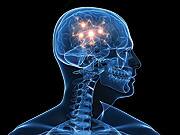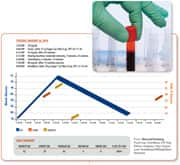Life Extension Magazine®
| Life Extension Magazine® often includes articles about calorie restriction (CR) and with good reason: LEF members want to know more when they learn that CR might help them live longer and protect against the chronic diseases that kill or reduce the quality of life for too many people—cancer, diabetes, and heart and Alzheimer’s disease. But what is calorie restriction really? Media descriptions vary. One famous reporter declared that to be calorie-restricted people must limit calories by 20% to 40% and remain thin for life–thus concluding that CR would be too difficult for most people. In reality, human CR is very different from the low-calorie regimens imposed on laboratory animals, on which many media stories are based. Humans have choices. We are free to adopt a CR regimen that works for our lives and temperaments. While some may limit calories by 20% or 30%, others may choose to just dip their toes in with a 5% reduction to get some benefits.1 Still, many people are unable to stick to a CR diet or, for that matter, any diet. Emotional challenges get in the way. Consider this scenario: It’s the middle of the night and feelings of hunger awaken you. How will you handle it? Without thinking, many people simply eat something and try to go back to sleep. Yet, you want to lose a few pounds: Only a couple of days ago, you made a resolution to go on a diet. You promised yourself that this time you would stick with it. And you’ve been doing fairly well. So you try to go back to sleep, but your mind wanders until you begin to focus on that delicious piece of chocolate layer cake in the refrigerator. Chocolate is one of your favorite flavors. You picture thick, rich, moist devil’s food, layered with chocolate frosting, sprinkled with generous bits of chocolate for bites of intense flavor. It would taste so good. Then you begin to think: Life was hard this week and I deserve a reward for all I had to put up with. The cake will make me feel better. So you find yourself getting out of bed, going to the refrigerator, taking the cake and putting it on a plate. You eagerly anticipate the sensual pleasure of chocolate. You warm some milk and sit in your favorite chair, slowly savoring each bite, feeling a glow of satisfaction while saying to yourself, One time won’t matter: I’ll lose the extra calories with exercise later today. But you don’t. In a few days you have worked your way back to your old eating habits and have actually gained a pound or two. Does this sound familiar? Millions of people start diets only to find that after a few days, they can’t continue with them, even if they have serious health issues from being overweight. Why are they so easily tempted by cake and other comfort foods that entice them away from their diet? Do they have less will power than others? Science says no. Research shows that anxiety and stress activate internal biochemistry that results in food cravings,2,3 ultimately making people turn to food for comfort—whether they are hungry or not. But what if you could gain control of the areas of the brain that regulate your feelings—replacing negative, self-limiting thoughts with positive ones? This is the revolutionary approach of The CR Way to Happy Dieting, a way of eating and living that empowers users with happiness biochemistry. This makes dieting easy and fun. Rather than focusing on how many calories to cut, The CR Way to Happy Dieting starts with emotional health by encouraging use of a “Happiness Gauge” to evaluate how you feel most of the time. Then users begin a unique, scientifically validated approach to increasing happiness by following six easy “Steps to Happiness.” Meal plans are specially formulated to help people increase critical mood modulators, proven to control eating habits. As users implement the meal plans, they are encouraged to revisit the happiness gauge, continuing to work on the steps until their self evaluation is positive and optimistic. The meal plans are laden with delicious recipes and food combinations that help users customize their own CR Way plan. For those who don’t have time to fix food, the “CR Way to Fast Foods” meal plan presents only dishes that can be prepared in five minutes or less. Serotonin for Dietary ControlThe first step to increasing happiness biochemistry focuses on serotonin, a neurotransmitter that works within the arcuate nucleus of the brain’s hypothalamus to regulate food intake. Understanding how food choices can increase serotonin may make the difference between dietary success and failure because serotonin generates signals that control mood, appetite, and satiety. In cases like the dieter described on the previous page who gives in to a tempting piece of chocolate cake, serotonin levels may determine whether the cake will be eaten or easily forgotten. Low levels of serotonin are linked to eating disorders and depression. Higher serotonin levels help us resist foods we don’t need, even when delicious temptations are readily available. Serious serotonin-signaling malfunction can drive people to anorexia or obesity. Serotonin is inextricably linked to brain levels of its amino acid precursor, tryptophan. Knowing this motivates many health-conscious individuals who want increased serotonin levels to eat turkey, milk, or other foods that are high in tryptophan. Yet high protein-rich foods do not facilitate tryptophan’s absorption into the brain where it increases serotonin levels because competing amino acids in foods like turkey and dairy products block tryptophan absorption, John D. Fernstrom and Richard Wurtman explain in their milestone study at MIT. When even larger elevations of plasma tryptophan are produced by the ingestion of protein-containing diets, brain tryptophan and serotonin do not change. The main determinant of brain tryptophan and serotonin concentrations does not appear to be plasma tryptophan alone, but the ratio of this amino acid to other plasma neutral amino acids (that is, tyrosine, phenylalanine, leucine, isoleucine, and valine) that compete with it for uptake into the brain.4 The consumption of carbohydrates, on the other hand, causes brain tryptophan to rise. The reason is that the high amount of insulin released in response to carbohydrate ingestion accelerates the serum removal of valine, leucine, and isoleucine that compete against tryptophan for transport into the brain.5,6 In fact, high carbohydrate meals that provoke serotonin increase are unmistakable: The relaxation and sense of calm that follow are quite noticeable. Healthy serotonin levels are so important to dietary success that The CR Way to Happy Dieting includes a filmed demonstration of how to prepare an easy serotonin-provoking recipe. Appropriately named “Relaxation Soup,” it takes less than two minutes to fix. The recipe includes an option to further increase the relaxation effect, depending upon how you feel and how you like to enjoy your soup.
This filmed demonstration introduces the recipe section where The CR Way recipes are listed according to their serotonin effect. Recipes, as well as daily meal plans designed to increase serotonin levels, are provided. Neuropeptide Y: Opposite of Serotonin?Neuropeptide Y (NPY) is another major regulator of dietary intake. It stimulates appetite while serotonin helps you stop eating by letting you know that you are getting full. When people eat meals that are high in sugar and fat—often in response to stress, NPY secretion increases.7 It also sends powerful signals that increase food consumption. So sugary and high-fat foods, which stimulate NPY, perpetuate a cycle of desire that motivates eating more and more.
Neuropeptide Y also initiates the formation of new fat cells in the abdomen. Research shows that increasing fat accumulation in this area elevates risk for heart disease, diabetes, and cancer. In a study at Georgetown University Medical Center, mice actually developed potbellies from increased NPY stimulation.8 Neuropeptide Y can be controlled in part by healthful food selections, and The CR Way to Happy Dieting can help. The recipe section includes nutritious recipes that contain healthful amounts of fat and sugar, found in foods naturally. But the meal plans go much further: By increasing serotonin they help protect the dieter from bouts of stress—reducing the desire to reach for sweets for comfort. Dietary Control from the Command CenterTo provide further help for dealing with stressful situations, the sixth “Step to Happiness” activates the brain’s frontal cortex. This part of the brain issues the executive orders that organize eating behaviors. Here the left prefrontal cortex is a key player. A recent study shows that when this area is activated, dietary restraint (a research term for controlling what you eat) is easier.9 Out of this knowledge the important Happiness Step 6 evolved, “Centering Meditation.” This section features a live podcast, which we encourage dieters to listen to and practice for ten to fifteen minutes every day. The “Centering Meditation” was influenced by centuries-old Tibetan meditation traditions that research has shown to be highly effective in activating the left prefrontal cortex.10 Activation of the left prefrontal cortex is associated with optimism while activation of the right prefrontal cortex coincides with depression. The need to help users master this important step to dietary control mandated that The CR Way to Happy Dieting be a multimedia presentation that includes videos and podcasts. For example, soft, reassuring music accompanies the guided “Centering Meditation” to facilitate entering a relaxed, contemplative state. Certainly, life’s challenges tempt us to seek comfort from food. And if the food and the amount are healthful, that is okay. If you understand how to eat and live to increase your emotional well-being, you will lose weight if you need to and you will keep it off. Most important, your life will be happier, healthier, and more productive. Take the Guesswork Out of Your Diet
We are known worldwide for our extraordinary health, achieved by following The CR Way. We attribute much of what we have accomplished to tracking our dietary intake with NutriBase software, the most accurate and full-featured nutrition and fitness software we’ve found. It is widely used by people who want precision and accuracy—including professionals in the business of health and fitness. We originally became aware of NutriBase when we needed software to use for the CR Society’s “Effects of CR on Humans” pilot study that preceded the “Long-term Effects of CR on Humans” studies11 at Washington University in Saint Louis School of Medicine. Out of all its competitors NutriBase was chosen to be used in the pilot study. Since then we have worked with NutriBase to create the NutriBase CR Way Edition. This groundbreaking software downloads to a home computer, giving dieters tools to immediately take control of their health. If you need to lose weight, you can enter your weight-loss goals into the NutriBase CR Way Edition and it will calculate a healthful number of pounds to lose each week, along with the appropriate calorie intake to achieve your goal. The software comes loaded with meal plans that improve mood, empowering you to leave unhealthful comfort foods behind. The NutriBase CR Way Edition’s extensive tracking capabilities eliminate guesswork that leads to unhealthful outcomes. It makes tracking easy—weight as well as calorie and nutrient intake, including fatty acids and phytochemicals. You can also track exercise, glucose levels, heart health, and even mood. Glucose Control for LongevityThe unparalleled glucose-tracking capabilities of the software were included especially for those who hope to activate energy-sensitive longevity genes. Glucose is such an important fuel for cellular energy production that when fasting levels fall to the 80 mg/dL range (normal reference range: 60-99 mg/dL) or below, cells switch from energy storage mode to energy production. The switch includes a shift from production of insulin, the hormone of plenty, with cellular uptake of glucose, to production of glucagon, the energy-stabilizing hormone. Along with glucagon, other energy-producing biochemistry is activated, including cell signals that are at the root of calorie restriction benefits.12-14 So just by using a glucometer and tracking how high glucose rises after meals, LEF members can get a sense of how well their age-slowing systems are working!
By using a glucometer to test the glucose effects of their foods and meals, users fine tune their choices to keep glucose levels low. Time-stamping glucose measurements, as well as carbohydrate intake and exercise, is another helpful capability of the software. This feature allows accurate charting of dietary intake and exercise effects on blood glucose levels, giving users deep insights into their glucose status and perhaps the real effectiveness of their age-slowing regimen. This slide, taken from a presentation by The CR Way co-author Paul McGlothin,15 illustrates the software’s precise tracking capabilities: The International Diabetes Federation names high glucose a risk factor not only for diabetes, but also for heart disease, cancer, atherosclerosis, macular degeneration, and a number of other dangerous health problems.16 Conversely, keeping glucose low can improve memory; protect against cancer, diabetes, and heart, kidney, and Alzheimer’s disease; as well as activate longevity biochemistry associated with extended life span.17 Many people who are serious about healthy life extension do not have access to laboratories that perform expensive genetic testing. By tracking the glucose effects of meals and exercise, one can get a good sense of how genes are being activated. Support Includes Friendly, Live Technical Assistance
The NutriBase CR Way Edition software is now part of the benefits for Longevity-Level Members of Living The CR Way, the progam for people who want to use proven science to slow or even reverse age-related decline. Unique content includes—
Teleconferences!CR experts, Paul McGlothin and Meredith Averill, lead live discussions and answer your questions. To find out about joining Living The CR Way and obtaining all these benefits, visit www.LivingTheCRWay.com If you have any questions on the scientific content of this article, please call a Life Extension® Wellness Specialist at Meredith Averill and Paul McGlothin are co-authors of The CR Way (HarperCollins, 2008) and they lead The CR Way Longevity Center. | |||||||||
| References | |||||||||
| 1. Hsieh EA, Chai CM, Hellerstein MK. Effects of caloric restriction on cell proliferation in several tissues in mice: role of intermittent feeding. Am J Physiol Endocrinol Metab. 2005 May;288(5):E965-72. 2. Gibson EL. Emotional influences on food choice: sensory, physiological and psychological pathways. Physiol Behav. 2006 Aug 30;89(1):53-61. 3. Martyn-Nemeth P, Penckofer S, Gulanick M, Velsor-Friedrich B, Bryant FB. The relationships among self-esteem, stress, coping, eating behavior and depressive mood in adolescents. Res Nurs Health. 2009 Feb;32(1):96-109. 4. Fernstrom JD, Wurtman RJ. Brain serotonin content: physiological regulation by plasma neutral amino acids. Science. 1972 Oct 27;178(59):414-6. 5. Lieberman HR, Caballero B, Finer N. The composition of lunch determines afternoon plasma tryptophan ratios in humans. J Neural Transm. 1986;65(3-4):211-7. 6. Heraief E, Burckhardt P, Mauron C, Wurtman JJ, Wurtman RJ. The treatment of obesity by carbohydrate deprivation suppresses plasma tryptophan and its ratio to other large neutral amino acids. J Neural Transm. 1983;57(3):187-95. 7. Kuo LE, Czarnecka M, Kitlinska JB, Tilan JU, Kvetnansky R, Zukowska Z. Chronic stress, combined with a high-fat/high-sugar diet, shifts sympathetic signaling toward neuropeptide Y and leads to obesity and the metabolic syndrome. Ann N Y Acad Sci. 2008 Dec;1148:232-7. 8. Kuo LE, Kitlinska JB, Tilan JU, et al. Neuropeptide Y acts directly in the periphery on fat tissue and mediates stress-induced obesity and metabolic syndrome. Nat Med. 2007 Jul;13(7):803-11. 9. Ochner CN, Green D, van Steenburgh JJ, Kounios J, Lowe MR. Asymmetric prefrontal cortex activation in relation to markers of overeating in obese humans. Appetite. 2009 Aug;53(1):44-9. 10. Lutz A, Greischar LL, Rawlings NB, Ricard M, Davidson RJ. Long-term meditators self-induce high-amplitude gamma synchrony during mental practice. Proc Natl Acad Sci U S A. 2004 Nov 16;101(46):16369-73. 11. Available at: www.livingthecrway.com/scienceTheCalorieRestriction SocietyResearchProject.aspx. Accessed July 28, 2010 12. Feng Z, Hu W, de Stanchina E, et al. The regulation of AMPK beta1, TSC2, and PTEN expression by p53: stress, cell and tissue specificity, and the role of these gene products in modulating the IGF-1-AKT-mTOR pathways. Cancer Res. 2007 Apr 1;67(7):3043-53. 13. Canto C, Elliott PJ, Puigserver P, et al. AMPK regulates energy expenditure by modulating NAD+ metabolism and SIRT1 activity. Nature. 2009 Apr 23;458(7241):1056-60. 14. McGlothin P, Averill M. Glucose Control: The Sweet Spot in Longevity. In: McGlothin P, Averill M. The CR Way: Using the Secrets of Calorie Restriction for a Longer, Healthier Life. New York, NY: HarperCollins; 2008: 57-78. 15. McGlothin P. The Other Side: “Chronic” Caloric Restriction for Healthy Living—Insights from those Successful at CR: Increased Happiness to Facilitate Long-Term Calorie Restriction. Presented at: Dallman Symposium on Obesity: Environmental, Psychological, and Biological Perspectives. UCSF; February 19, 2010. 16. Available at: http://www.idf.org/webdata/docs/Guideline_PMG_final.pdf. Accessed July 28, 2010. 17. McGlothin P, Averill M. The CR Way: Using the Secrets of Calorie Restriction for a Longer, Healthier Life. New York, NY: HarperCollins; 2008. |





